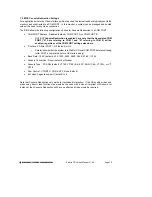
Elektra CPU User Manual V1.00
Page 28
7. BIOS
7.1 BIOS Settings
ELEKTRA uses a BIOS from Phoenix Technologies modified to support the custom features of
the ELEKTRA board. Some of these features are described here.
To enter the BIOS during system startup (POST – power on self-test), press F2.
Serial Ports
-The address and interrupt settings for serial ports COM1, COM2, COM3, and COM4 may be
modified. COM port address and interrupt settings are done in the BIOS, Advanced menu, I/O
Device Configuration. See page 31 for details.
Select Advanced menu, Advanced Chipset Control, I/O Chip Device Configuration.
Parallel Port
The parallel port is configured in the Advanced -> I/O Chip Device Configuration menu. It is set
by default to ECP mode and located at address 0x378, IRQ 7 and DMA 3.
You can move the base address to 0x278 or 0x3BC. The IRQ can be set to 5 or 7. The DMA
can be set to 1 or 3.
Miscellaneous
-Memory Cache Settings:
Unless there is a specific reason to change these settings, it is best to keep these settings as-is.
Certain system functions (such as USB keyboard support under BIOS menus) may be adversely
affected by changes to these settings, due mainly to a heavy reduction in performance. These
cache settings can make a huge difference for low-level BIOS calls and, as such, can severely
limit performance if they are disabled.
The Frame Buffer size can be increased for specific applications; just be aware that an increase
in this memory size will result in a decrease in overall system memory available. The AGP rate
affects internal video accesses and does not affect any external bus speeds.
“Expansion Bus Performance” is an adjustment to allow an increase in ISA I/O Access speeds.
For applications where ISA I/O accesses seem to be a limiting factor, this performance may be
increased to “Accelerated”. Be aware that increasing these timings may adversely affect system
stability with external add-on PC/104 cards. This setting has no direct affect on PCI or memory
speeds; it only affects ISA PC/104 devices. It is best to leave this setting at “Normal” if there are
no ISA I/O Performance issues.
- On the Advanced screen, the following settings should be retained:
Installed O/S
Win98
Large Disk Access Mode
DOS
- On the On-Chip Multifunction Device screen, the following settings should be retained:
USB Device
Enabled
Legacy Audio
Disabled
“Legacy Audio” will only affect DOS-based applications when used with the VIA-supported
DOS Drivers. Enabling this setting will require system I/O, IRQ, and DMA resources. It is
strongly recommended that this setting be left “Disabled.”






























